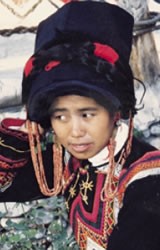Wumeng is an ancient tribal name that has been used for centuries to describe this people. It is probably just a loconym invented by the Chinese because this group lives in the Wumeng Mountain range. It is uncertain what name the Wumeng use for themselves, or whether they have adopted the use of Wumeng as their name.
The Wumeng are relatively recent arrivals in the region, having migrated there within the last 300 to 400 years. Their situation was described by Samuel Clarke, who wrote that "two days to the north of Anshun begin the estates and residences of the large Nosu [Yi] landholders, which stretch away as far as Zhaotong, Yunnan, one hundred and fifty miles away as the crow flies."
In the past the Wumeng were relatively wealthy slaveholders and landlords. Today, they are still a proud people who discourage intermarriage with other ethnic groups, including other people classified as "Yi." In recent years a few Wumeng have married partners from other ethnic groups, only to have their families disown them and cut them off.
Polytheism, ancestor worship, and, in the past century, Christianity are the main religions among the Wumeng.
The Paris Foreign Missionary Society commenced work in Zhaotong in 1780. The China Inland Mission and the Methodists arrived in the area at the start of the twentieth century. On Christmas Day, 1905, Samuel Pollard recorded in his diary: "This Christmas for the first time we have had [Yi] visitors. More than thirty came as a result of the preaching of Mr. Wang. They are a strange-looking lot, much wilder than the Miao, and fiercer-looking. One of them was a Yi wizard who taught me some characters. They say there are about eight or nine hundred families who wish to come. Does this mean that salvation for them has come at last?" By the 1990s, there were approximately 5,000 Wumeng Christians in northeastern Yunnan, meeting in small house fellowships throughout the mountains.
Like all people everywhere, the Wumeng people need more of Jesus.
Thank the Lord for these Wumeng Christians!
Pray the Wumengs will evangelize and disciple others.
Pray for the Holy Spirit to move mightily in Wumeng families, leading them to worship and serve the only savior.
Scripture Prayers for the Wumeng in China.
Operation China, Asia Harvest, Copyrighted Used with permission.
| Profile Source: Joshua Project |










